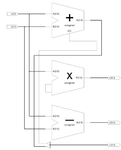David83
Advanced Member level 1
Hello all,
How can I draw the schematics of my RTL verilog code. Something like the attached figure. I use ModelSim to write and simulate my design. Does it support this? Also, is finding such schematic is the synthesis process itself or it's something different?
Thanks
How can I draw the schematics of my RTL verilog code. Something like the attached figure. I use ModelSim to write and simulate my design. Does it support this? Also, is finding such schematic is the synthesis process itself or it's something different?
Thanks
